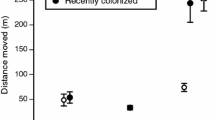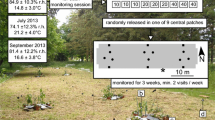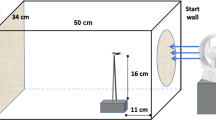Abstract
In invasive species, geographically variable evolutionary and ecological pressures can cause the rapid evolution of divergent behavioural phenotypes. Studies on invasive cane toads (Rhinella marina) in tropical Australia have revealed strong (and heritable) shifts in physiological traits related to dispersal rate. Behavioural phenotypes may have evolved in similar ways. We used standardised arena trials to test field-collected adult female toads from three populations: a range-core area in Queensland (ca. 76 years post-colonisation), a range-front population in Western Australia (<5 years post-colonisation) and an intermediate Northern Territory population (11 years post-colonisation). As predicted, toads from the range-front population were more exploratory and more likely to take risks in a novel arena environment than were conspecifics from the range-core population. We suggest that differential selection on behavioural responses to novel conditions in range-core versus range-front populations has produced a distinctive behavioural phenotype at the range-front that retains a high propensity for exploration and risk-taking (enhancing the ability of range-front toads to locate food and shelter) even when faced with novel environments. In contrast, at the range core where the locations of resources are known, a decrease in exploration and risk-taking in response to a novel environment may be favoured as it assists toads in evading threats.
Significance statement
Ongoing biological invasions provide an ideal opportunity to examine which phenotypic traits drive establishment, range-expansion and invasion success. Furthermore, ongoing invasions allow us to investigate if variation in evolutionary and ecological pressures across an invasion range leads to geographical divergence in phenotypic traits. Dispersal ability is a key factor in invasion success. Behavioural traits such as exploration and a propensity to take risks enhance dispersal as individuals with these traits rapidly move out of their existing range and exploit new habitats and resources. We studied geographic divergence of dispersal-related behavioural traits across the Australian invasion range of cane toads (Rhinella marina) using standardised laboratory trials. We found that range-front toads were more exploratory and more likely to take risks than were conspecifics from range-core areas. Our results suggest that dispersal-enhancing behavioural traits may be important drivers of invasion success in cane toads.



Similar content being viewed by others
References
Aragon P, Clobert J, Massot M (2006a) Individual dispersal status influences space use of conspecific residents in the common lizard, Lacerta vivipara. Behav Ecol Sociobiol 60:430–438
Aragon P, Meylan S, Clobert J (2006b) Dispersal status-dependent response to the social environment in the common lizard, Lacerta vivipara. Funct Ecol 20:900–907
Bowcock H, Brown GP, Shine R (2008) Sexual communication in cane toads (Bufo marinus): what cues influence the duration of amplexus? Anim Behav 75:1571–1579
Brodin T, Drotz MK (2014) Individual variation in dispersal associated behavioural traits of the invasive Chinese mitten crab (Eriocheir sinensis, H. Milne Edwards, 1854) during initial invasion of Lake Vanern, Sweden. Curr Zool 60:410–416
Brown GP, Shilton C, Phillips BL, Shine R (2007) Invasion, stress, and spinal arthritis in cane toads. P Natl Acad Sci USA 104:698–700
Brown GP, Kelehear C, Shine R (2013) The early toad gets the worm: cane toads at an invasion front benefit from higher prey availability. J Anim Ecol 82:854–862
Brown GP, Phillips BL, Shine R (2014) The straight and narrow path: the evolution of straight-line dispersal at a cane-toad invasion front. Proc R Soc B 281:20141385
Chapman BB, Hulthén K, Blomqvist DR, Hansson L-A, Nilsson JÅ, Brodersen J, Nilsson PA, Skov C, Brönmark C (2011) To boldly go: individual differences in boldness influence migratory tendency in a cyprinid fish. Ecol Lett 14:871–876
Chapple DG, Simmonds SM, Wong BB (2011) Know when to run, know when to hide: can behavioural differences explain the divergent invasion success of two sympatric lizards? Ecol Evol 1:278–289
Chapple DG, Simmonds SM, Wong BBM (2012) Can behavioural and personality traits influence the success of unintentional species introductions? Trends Ecol Evol 27:57–64
Cote J, Clobert J (2007) Social personalities influence natal dispersal in a lizard. Proc R Soc Lond B 274:383–390
Cote J, Clobert J, Brodin T, Fogarty S, Sih A (2010a) Personality-dependent dispersal: characterization, ontogeny and consequences for spatially structured populations. Philos T Roy Soc B 365:4065–4076
Cote J, Fogarty S, Weinersmith K, Brodin T, Sih A (2010b) Personality traits and dispersal tendency in the invasive mosquitofish (Gambusia affinis). Proc R Soc Lond B 277:1571–1579
Cote J, Fogarty S, Brodin T, Weinersmith K, Sih A (2011) Personality-dependent dispersal in the invasive mosquitofish: group composition matters. Proc R Soc Lond B 278:1670–1678
Dall SRX, Houston AI, McNamara JM (2004) The behavioural ecology of personality: consistent individual differences from an adaptive perspective. Ecol Lett 7:734–739
Dingemanse NJ, Both C, van Noordwijk AJ, Rutten AL, Drent PJ (2003) Natal dispersal and personalities in great tits (Parus major). Proc R Soc Lond B 270:741–747
Drent PJ, van Oers K, van Noordwijk AJ (2003) Realised heritability of personalities in the great tit (Parus major). Proc R Soc Lond B 270:45–51
Ducatez S, Crossland M, Shine R (2016) Differences in developmental strategies between long-settled and invasion-front populations of the cane toad in Australia. J Evol Biol 29:335–343
Duckworth RA (2006) Aggressive behaviour affects selection on morphology by influencing settlement patterns in a passerine bird. Proc R Soc Lond B 273:1789–1795
Duckworth RA (2008) Adaptive dispersal strategies and the dynamics of a range expansion. Am Nat 172:4–17
Duckworth RA, Badyaev AV (2007) Coupling of dispersal and aggression facilitates the rapid range expansion of a passerine bird. P Natl Acad Sci USA 104:15017–15022
Fisher KJ, Guilfoyle KJ, Hatch KA (2013) Stress induced by toe-clipping in cane toads (Rhinella marina). Copeia 2013:539–542
Fogarty S, Cote J, Sih A (2011) Social personality polymorphism and the spread of invasive species: a model. Am Nat 177:273–287
González-Bernal E, Brown GP, Shine R (2014) Invasive cane toads: social facilitation depends upon an individual’s personality. PLoS One 9:e102880
Groen M, Sopinka NM, Marentette JR, Fox MG, Reddon AR, Marsh-Rollo SE, Balshine S, Brownscombe JW (2012) Is there a role for aggression in round goby invasion fronts? Behaviour 149:685–703
Hudson CM, McCurry MR, Lundgren P, McHenry CR, Shine R (2016a) Constructing an invasion machine: the rapid evolution of a dispersal-enhancing phenotype during the cane toad invasion of Australia. PLoS One 19:e0156950
Hudson CM, Brown GP, Shine R (2016b) It’s lonely at the front: contrasting evolutionary trajectories in male and female invaders. Roy Soc open sci 3:160687
Indermaur L, Schmidt BR, Tockner K, Schaub M (2010) Spatial variation in abiotic and biotic factors in a floodplain determine anuran body size and growth rate at metamorphosis. Oecologia 163:637–649
Kolar CS, Lodge DM (2001) Progress in invasion biology: predicting invaders. Trends Ecol Evol 16:199–204
Lever C (2001) The cane toad. The history and ecology of a successful colonist. Westbury Academic and Scientific Publishing, Otley, West Yorkshire
Liebl AL, Martin LB (2012) Exploratory behaviour and stressor hyper-responsiveness facilitate range expansion of an introduced songbird. Proc R Soc Lond B 279:4375–4381
Liebl AL, Martin LB (2014) Living on the edge: range edge birds consume novel foods faster than established ones. Behav Ecol 25:1089–1096
Lindström T, Brown GP, Sisson SA, Phillips BL, Shine R (2013) Rapid shifts in dispersal behaviour on an expanding range edge. P Natl Acad Sci USA 110:13452–13456
Llewellyn J, Phillips BL, Alford RA, Schwarzkopf L, Shine R (2010) Locomotor performance in an invasive species: cane toads from the invasion front have greater endurance, but not speed, compared to conspecifics from a long-colonised area. Oecologia 162:343–348
McCann S, Greenlees MJ, Newell D, Shine R (2014) Rapid acclimation to cold allows the cane toad (Rhinella marina) to invade montane areas within its Australian range. Funct Ecol 28:1166–1174
Meylan S, de Fraipont M, Aragon P (2009) Are dispersal-dependent behavioural traits produced by phenotypic plasticity? J Exp Zool A 311:377–388
Monceau K, Moreau J, Poidatz J, Bonnard O, Thiéry D (2015) Behavioural syndrome in a native and an invasive hymenoptera species. Insect Sci 22:541–548
Myles-Gonzalez E, Burness G, Yavno S, Rooke A, Fox MG (2015) To boldly go where no goby has gone before: boldness, dispersal tendency, and metabolism at the invasion front. Behav Ecol 26:1083–1090
Phillips BL (2009) The evolution of growth rates on an expanding range edge. Biol Lett 5:802–804
Phillips BL, Brown GP, Webb JK, Shine R (2006) Invasion and the evolution of speed in toads. Nature 439:803
Phillips BL, Brown GP, Greenlees M, Webb JK, Shine R (2007) Rapid expansion of the cane toad (Bufo marinus) invasion front in tropical Australia. Austral Ecol 32:169–176
Phillips BL, Brown GP, Travis JMJ, Shine R (2008) Reid’s paradox revisited: the evolution of dispersal kernels during range expansion. Am Nat 172:34–48
Phillips BL, Brown GP, Shine R (2010) Evolutionarily accelerated invasions: the rate of dispersal evolves upwards during the range advance of cane toads. J Evol Biol 23:2595–2601
Réale D, Dingemanse NJ, Kazem AJN, Wright J (2010) Evolutionary and ecological approaches to the study of personality. Philos T Roy Soc B 365:3937–3946
Rehage JS, Sih A (2004) Dispersal behavior, boldness, and the link to invasiveness: a comparison of four Gambusia species. Biol Invasions 6:379–391
Riesch R, Duwe V, Herrmann N, Padur L, Ramm A, Scharnweber K, Schulte M, Schulz-Mirbach ZM, Plath M (2009) Variation along the shy-bold continuum in extremophile fishes (Poecilia Mexicana, Poecilia sulphuraria). Behav Ecol Sociobiol 63:1515–1526
Rollins LA, Richardson MF, Shine R (2015) A genetic perspective on rapid evolution in cane toads (Rhinella marina). Mol Ecol 24:2264–2276
Shine R, Brown GP, Phillips BL (2011) An evolutionary process that assembles phenotypes through space rather than through time. P Natl Acad Sci USA 108:5708–5711
Sih A, Bell A, Johnson JC (2004) Behavioural syndromes: an ecological and evolutionary overview. Trends Ecol Evol 19:372–378
Simmons AD, Thomas CD (2004) Changes in dispersal during species’ range expansions. Am Nat 164:378–395
van Oers K, Drent PJ, de Jong G, van Noordwijk AJ (2004) Additive and nonadditive genetic variation in avian personality traits. Heredity 93:496–503
Verbeek MEM, Drent PJ, Wiepkema PR (1994) Consistent individual differences in early exploratory behaviour of male great tits. Anim Behav 48:1113–1121
Wilson DS, Coleman K, Clark AB, Biederman L (1993) Shy-bold continuum in pumpkinseed sunfish (Lepomis gibbosus): an ecological study of a psychological trait. J Comp Psychol 107:250–260
Wilson DS, Clark AB, Coleman K, Dearstyne T (1994) Shyness and boldness in humans and other animals. Trends Ecol Evol 9:442–445
Wright TF, Eberhard JR, Hobson E, Avery ML, Russello M (2010) Behavioural flexibility and species invasions: the adaptive flexibility hypothesis. Ethol Ecol Evol 22:393–404
Zug GR, Zug PB (1979) The marine toad Bufo marinus: a natural history resumé of native populations. Smithson Contrib Zool 284:1–58
Acknowledgements
We thank Cameron Hudson and Damian Holden for their assistance with toad collection, Simon Ducatez and Jayna Devore for help with analyses, and Lorene Chieze for assistance with trials and husbandry. We also thank two anonymous reviewers for their valuable comments. This work was funded by the Australian Research Council (FL120100074).
Author information
Authors and Affiliations
Corresponding author
Ethics declarations
Ethical approval
All applicable international, national, and institutional guidelines for the care and use of animals were followed. Ethical approval for this study was granted by the Macquarie University Animal Ethics Committee under protocol number: ARA2013/035 and the University of Sydney Animal Ethics Committee under animal ethics project number: 2013/5805. All procedures performed in studies involving animals were in accordance with the ethical standards of the institutions under which the studies were conducted. This article does not contain any studies with human participants performed by any of the authors.
Additional information
Communicated by K. Summers
Rights and permissions
About this article
Cite this article
Gruber, J., Brown, G., Whiting, M.J. et al. Geographic divergence in dispersal-related behaviour in cane toads from range-front versus range-core populations in Australia. Behav Ecol Sociobiol 71, 38 (2017). https://doi.org/10.1007/s00265-017-2266-8
Received:
Revised:
Accepted:
Published:
DOI: https://doi.org/10.1007/s00265-017-2266-8




